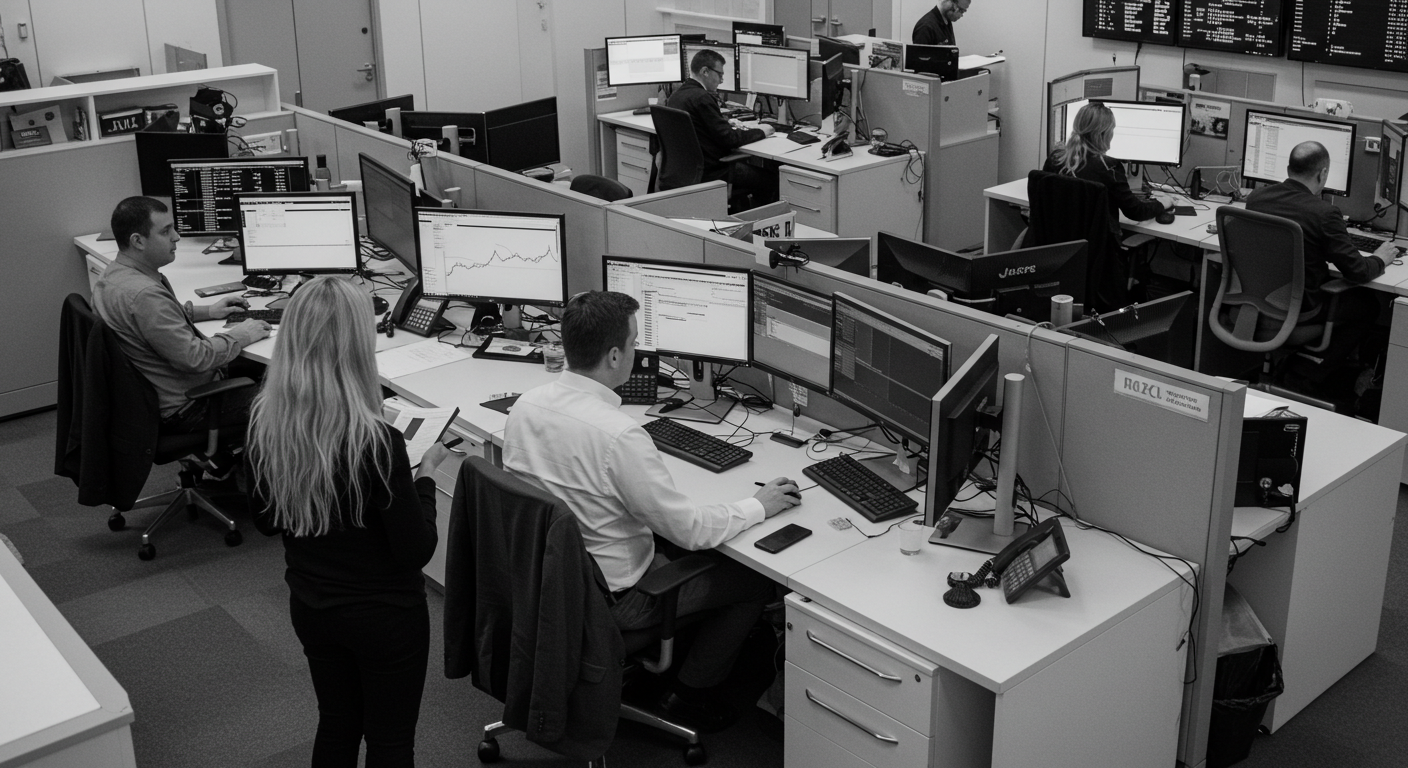Trying to decide between CFD trading and traditional stocks? The “CFD vs stock” debate is more than a simple choice, especially for traders exploring new possibilities in Web3 and innovation-driven markets. Both options offer different ways to access financial markets, but they come with unique benefits and risks.
CFDs (Contracts for Difference) allow you to trade price movements without owning the asset, which means flexibility and often lower capital requirements. Stocks, on the other hand, offer direct ownership and long-term value.
Understanding how these two work is key for Web3 traders and investors aiming to make smarter, well-informed choices as the worlds of crypto and traditional finance connect.
What is CFD Trading?
CFD trading, short for Contract for Difference trading, lets you trade the price swings of financial assets without owning them. You simply buy or sell a contract based on whether you expect the asset’s price to rise or fall. As a result, you get the difference between your entry and exit prices, which can be a gain or a loss.
This style of trading has become popular with those who value flexibility, since you can access various global markets, use leverage to control larger positions with smaller capital, and take positions both up and down (long or short) on many financial products.
Unlike traditional shares, you don’t own a piece of the company or asset. You’re just predicting its price movement.
Advantages of CFD Trading
People choose CFDs for several reasons that set them apart in the “CFD vs stock” debate. Here are the main benefits:
- Leverage: With CFDs, you only need to put down a fraction of the full trade value, thanks to margin requirements. This means your potential gains (and losses) are amplified compared to trading the underlying asset directly.
- Access to Global Markets: You can trade CFDs on a wide range of markets including shares, cryptocurrencies, commodities, indices, and forex, all from a single account.
- Flexible Trading Hours: Unlike traditional stock markets that close at the bell, many CFD markets operate nearly 24/7, letting you act on market-moving events at almost any time.
- Hedging Options: Traders often use CFDs to hedge existing portfolios. For example, if you hold actual stocks but expect short-term volatility, you can open opposite positions using CFDs to offset potential losses.
If you’d like to see this level of flexibility in action, our guide on what is CFD trading and how does it work explains how these benefits play out in real trading.
Risks and Considerations in CFD Trading
While CFDs can offer a flexible way to engage with multiple asset classes, there are several risks traders must respect:
- Amplified Losses Due to Leverage: The same leverage that boosts potential gains also means losses are magnified. You can lose more than your initial deposit if markets move sharply against your position.
- Margin Calls: If your balance drops below the required maintenance margin, your broker may issue a margin call. You’ll need to deposit more funds quickly, or your position may be closed automatically to limit further losses.
- Counterparty Risk: When you trade CFDs, you’re trading with your broker, not a centralized exchange. If the broker fails (for example, because of insolvency), you could lose your funds.
You should only trade CFDs with money you can afford to lose and understand that managing your risk is as important as spotting opportunities.
CFD trading sits at the intersection of speed, flexibility, and high risk. Weighing these features against the more stable and direct approach of owning stocks is essential in any “CFD vs stock” decision.

What is Stock Trading?
Stock trading is the practice of buying and selling shares of companies through a public exchange, giving you actual ownership in the business.
When you buy a company’s stock, you’re not just speculating on its price, you become a part-owner with certain rights and privileges. Unlike products like CFDs, stock trading connects you directly to the performance and future of real-world companies.
Buying stocks means you can benefit from a company’s growth, take part in shareholder votes, and possibly receive a share of profits through dividends. Compared to CFD trading in the “CFD vs stock” debate, trading stocks ties your investment to tangible equity, aligning your success with the business itself.
Benefits of Stock Trading
Trading actual stocks has several clear advantages for many investors. Some of the standout benefits include:
- Steady Growth Opportunities: Stocks help you build wealth gradually. By investing in quality companies, you can ride the general rise of the market over time.
- Reduced Risk Compared to Leveraged Products: Since most stock trading doesn’t use much leverage, your losses are limited to your investment. CFD trading, on the other hand, can result in losses larger than your initial deposit due to high leverage.
- Access to Dividends: Stockholders often receive dividends, a portion of company profits paid to shareholders. This creates a source of passive income in addition to stock price gains.
- Long-Term Wealth Creation: Historically, investing in stocks is one of the most reliable paths to long-term financial growth. You benefit from both price appreciation and compounding returns.
Owning stocks puts you in the driver’s seat of building long-term value, while products like CFDs are usually designed for short-term speculation.
Risks and Limitations of Stock Trading
Stock trading isn’t risk-free, and it comes with its own set of constraints:
- Market Volatility: Stock prices can swing sharply within a day due to news, earnings, or market mood. Big drops in price can impact your portfolio quickly.
- Limited Leverage Unless Using Margin: Most stock traders buy shares using their own cash, unless they open margin accounts. Margin accounts offer some leverage but require extra monitoring and carry their own risks, such as margin calls if the stock falls too much.
- Short-Selling Complexities: Making money when a stock drops (short selling) is more complicated with stocks than CFDs. It involves borrowing shares, and can carry unlimited risk if the stock price goes up instead.
- Exposure to Market Hours Only: Traditional stock markets have set trading hours. Once the exchange closes, you can’t buy or sell until it reopens, which limits the ability to react to overnight news.
Understanding these risks highlights why some traders prefer flexible, around-the-clock products like CFDs, but does not make stock ownership any less valuable for long-term wealth building.
Modern investors and Web3 traders need to weigh these factors carefully in the CFD vs stock decision, as each approach offers unique ways to grow your portfolio or manage risk. For a deep dive into the basics of equity investing, you can also read this helpful overview on how to invest in stocks from NerdWallet.

CFD vs Stock: Key Differences Explained
Before you decide if CFDs or stocks fit your trading style, it helps to get clear about what sets them apart. Both open doors to the markets, but each works by different rules and comes with its own set of practical considerations.
Let’s break it down in a simple, side-by-side way, so you can see the distinctions at a glance.
1. Ownership and Asset Exposure
At the heart of the CFD vs stock debate is the nature of what you actually hold.
- CFDs: When you trade CFDs, you never own the underlying asset. Instead, you’re entering into a contract based on the price movement of that asset. You’re speculating on whether the price will rise or fall, but you don’t get shareholder rights or dividends.
- Stocks: Buying stocks means you own a piece of the company outright. This gives you rights such as voting at shareholder meetings and, if the company pays them, earning dividends.
2. Leverage: Amplifying Gains and Losses
The way you trade with borrowed funds is another major difference.
- CFDs: CFDs offer built-in leverage, meaning you can control a larger position with a smaller upfront investment. While this amplifies profits, it also increases your risk. Losses can sometimes exceed your deposit.
- Stocks: Stock trading typically requires you to pay the full share price upfront unless you use a margin account. Even then, the leverage is lower than CFDs, so your risk is more limited.
3. Market Access and Diversification
How and where you can trade each type makes a difference:
- CFDs: Give you access to a wide array of assets from one account, think stocks, commodities, forex, and crypto. It’s simple and streamlined, especially for those who want to trade across markets.
- Stocks: Mostly limited to company shares listed on public exchanges. While ETFs and mutual funds add diversification, direct access outside equities typically isn’t built in.
4. Trading Hours
When you can buy or sell shapes your strategies.
- CFDs: Most CFD platforms allow trading nearly 24 hours a day, especially for global indices, forex, and even cryptocurrencies. This lets you react instantly to breaking news.
- Stocks: Trades are restricted to stock market hours. While pre-market and after-hours trading is possible, it comes with less liquidity and higher spreads.
5. Profit Opportunities
Both CFDs and stocks let you benefit from price moves, but the mechanics aren’t the same.
- CFDs: Enable both “going long” (buying) and “going short” (selling) with the same ease. You can potentially profit in rising or falling markets without extra paperwork.
- Stocks: You profit when the stock price rises or through dividends. Short-selling is more complex and may carry unlimited risk if the stock price soars.
6. Regulation and Tax Considerations
Rules and taxes can be the deciding factors for many traders.
- CFDs: Generally regulated as derivatives or financial products, depending on the country. Rules are strict in the UK, EU, and Australia, with some regions banning retail CFD trading altogether. Profits or losses might be taxed differently than capital gains on stocks, sometimes as regular income.
- Stocks: Investors are protected by well-established regulations and insurance on most major exchanges. Taxes usually treat gains as capital gains, often at lower rates for long-term holders. Dividend income is generally taxed, but rates vary by country.
Tax issues and regulations can be a headache, so it’s smart to double-check the latest rules in your country or consult a financial advisor for clarity before trading either product.
CFD vs Stock: Quick Comparison Table
Here’s a simplified table to help you remember the big differences:
| Feature | CFDs | Stocks |
| Ownership | No asset ownership | Own shares of the company |
| Leverage | High (often 5:1 or more) | Low (usually 1:1, some margin) |
| Market Access | Multiple assets, global | Company stocks only |
| Trading Hours | Almost 24/7 | Limited to market hours |
| Profit Opportunities | Both rising and falling prices | Mainly rising prices, dividends |
| Regulation/Tax | Varies, often as derivatives | Well-established, capital gains |
Understanding these differences lets you tailor your trading approach to your goals, risk tolerance, and preferred market style. Each choice, whether you lean toward CFDs or stocks, comes with unique pros and cons. Knowing them is the first step to smarter, more confident trades.

When to Choose CFDs vs Stocks?
The decision between CFDs and stocks can shape your entire trading experience. Active traders, long-term investors and Web3 enthusiasts each have different needs.
Picking the right tool is about matching your strategy, risk comfort and capital goals to the features of each product. Staying ahead in trading means watching both technology and regulation.
The market for CFDs and stocks is shifting quickly, and these changes benefit some traders more than others. Let’s look at where today’s industry trends and innovations fit in.
1. Algorithmic Trading: Automated trading strategies aren’t just for Wall Street. More retail platforms integrate “algos” that execute trades at lightning speed, scanning data points far faster than a human could.
In CFDs, the lower costs and flexibility make this tech particularly attractive for high-frequency strategies. Stocks are catching up too, thanks to increased retail access to trading APIs.
2. Real-Time Analytics in CFD Platforms: Modern CFD brokers have upped their game with dashboards that deliver advanced analytics and customizable signals in real time.
Many platforms now mirror tools long used by professionals. This means retail traders can react to market events, spot opportunities, and manage risk much faster than in the past.
These analytics can help active traders pick CFDs for shorter-term, fast-moving strategies, while stocks may be better if you prefer a research-driven, longer-term plan.
3. Regulatory Shifts: Oversight is getting tighter in both CFD and stock markets. For stocks, regulators globally are pushing for more transparency, fairer pricing and stricter reporting.
CFD trading is under increased scrutiny, especially in places like the UK and Australia. Some regulators have put limits on max leverage or banned certain products to protect retail traders from quick losses.
4. Web3 Industry Relevance: Innovative Web3 platforms now offer blockchain-based trading and decentralized analytics. While many are focused on crypto spot markets, the lines are blurring.
Community-driven trading, tokenized assets, and DeFi protocols are inspiring new features in CFD and equity platforms. Decentralized finance lets traders tap into synthetic assets, which work like blockchain-based CFDs, offering exposure without ownership.
CFD vs Stock: Which to Pick?
- CFDs suit active traders and those who use analytics and market speed to catch short moves.
- Stocks better serve long-term investors wanting exposure to business growth, regulated ownership and possible dividends.
- Web3 traders and crypto-native investors can now mix DeFi and CeFi for even more flexibility, but remain aware of unique risks around security and compliance compared to regulated stock brokers.
Both stocks and CFDs are seeing major upgrades. The combination of better analytics, faster execution and regulatory change helps you customize your trading approach to what fits best, whether you like to move fast with CFDs, build long-term with stocks, or try new strategies inspired by Web3.
Conclusion: Making the Right Choice Between CFD and Stock
Choosing between CFD trading and traditional stocks is about finding what truly fits your trading style, comfort with risk, and financial goals. The “CFD vs stock” decision isn’t just technical, it’s personal, and the right pick makes your investing journey more rewarding.
Align Your Trading Style and Goals
Every trader hopes to match their strategy to the product that brings out their strengths. Some crave speed and flexibility, others want steady, long-term growth.
Weigh the Key Differences
Take a moment to sum up your personal priorities by thinking about these points:
- Risk Tolerance: Leverage in CFDs can offer high rewards but comes with a chance of bigger losses. Stocks, with lower leverage, provide a safer base for most.
- Market Access: If you want to trade across global markets and asset types, CFDs give flexibility. Stocks, on the other hand, keep things focused and familiar.
- Ownership vs. Speculation: Stocks make you an owner. CFDs make you a speculator. Decide what feels right for your own sense of control and reward.
Final Advice Before You Trade
The “CFD vs stock” debate boils down to understanding yourself. Start by asking:
- How much do you value flexibility?
- How important is long-term growth for you?
- How comfortable are you with risk, especially if leveraging with CFDs?
It’s smart to research carefully, try demo accounts, and read up on both products. No matter your path, make your choice informed, intentional, and aligned with your own goals. Keep learning and adapting as markets evolve. Your future self will thank you.

Adeyemi Adetilewa is a digital marketing strategist and writer with over a decade of experience helping B2B, SaaS, Web3, and eCommerce brands grow through data-driven marketing. Adeyemi empowers professionals and business owners with actionable insights, growth strategies, and digital tools for success.

